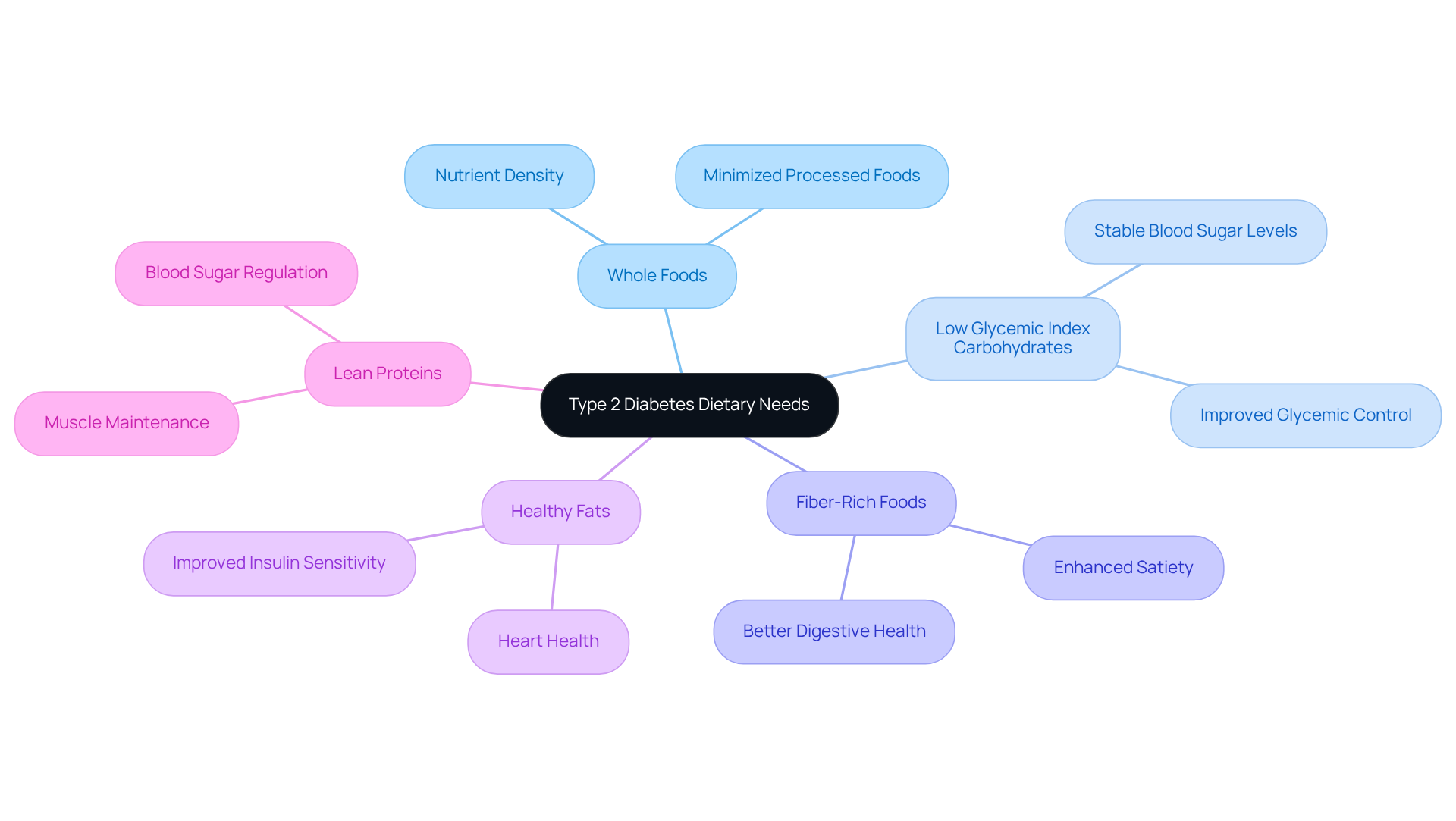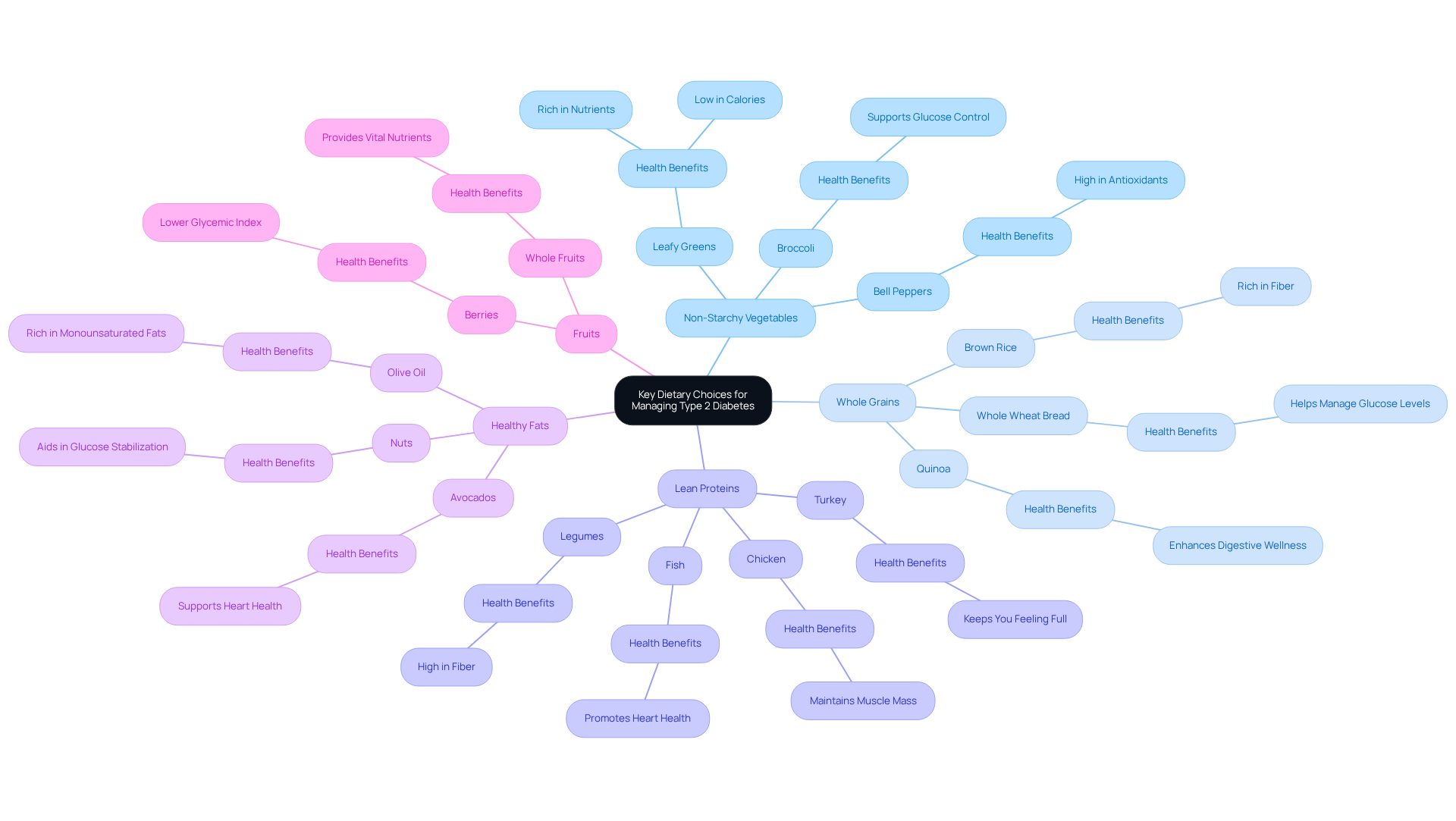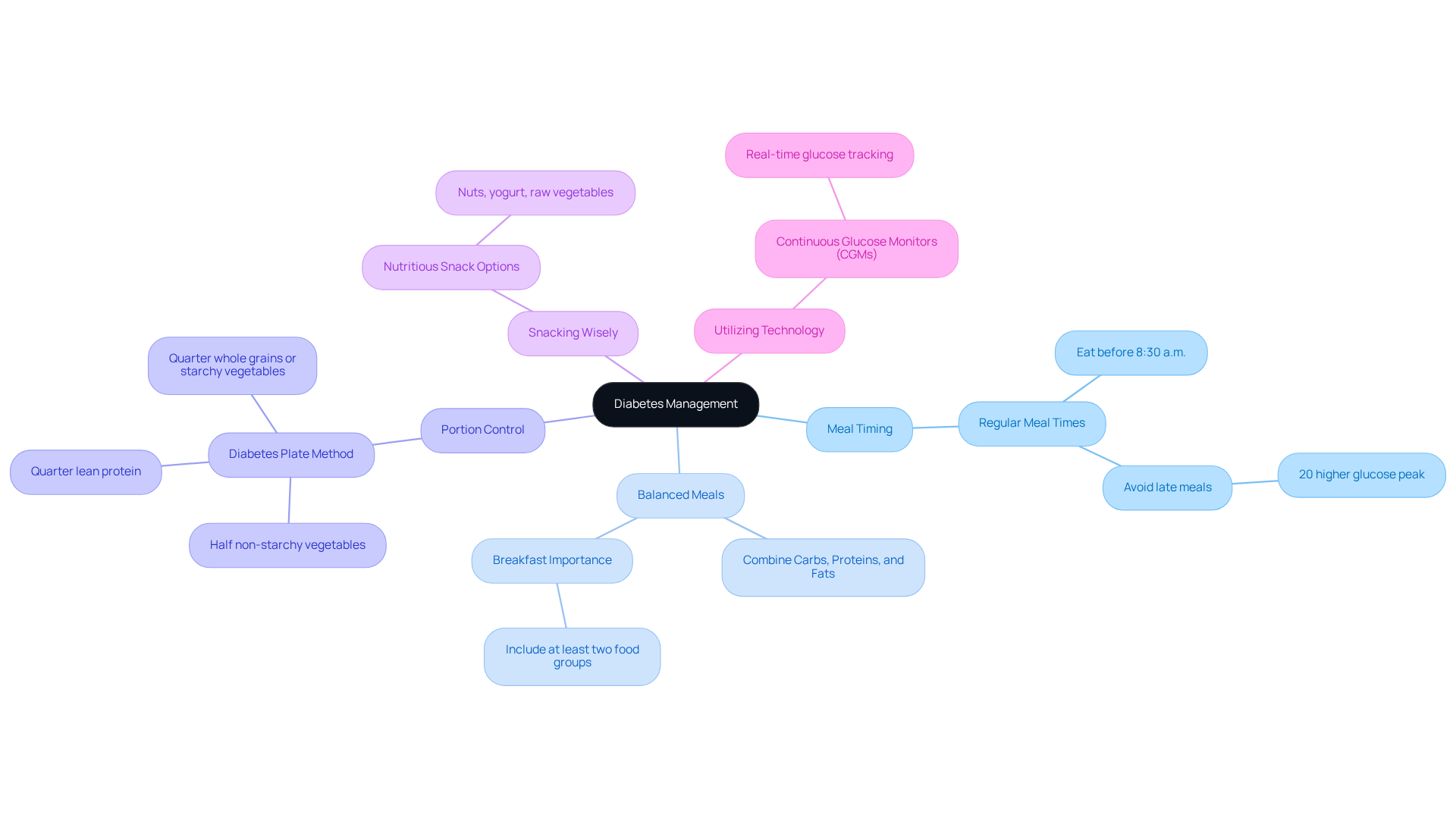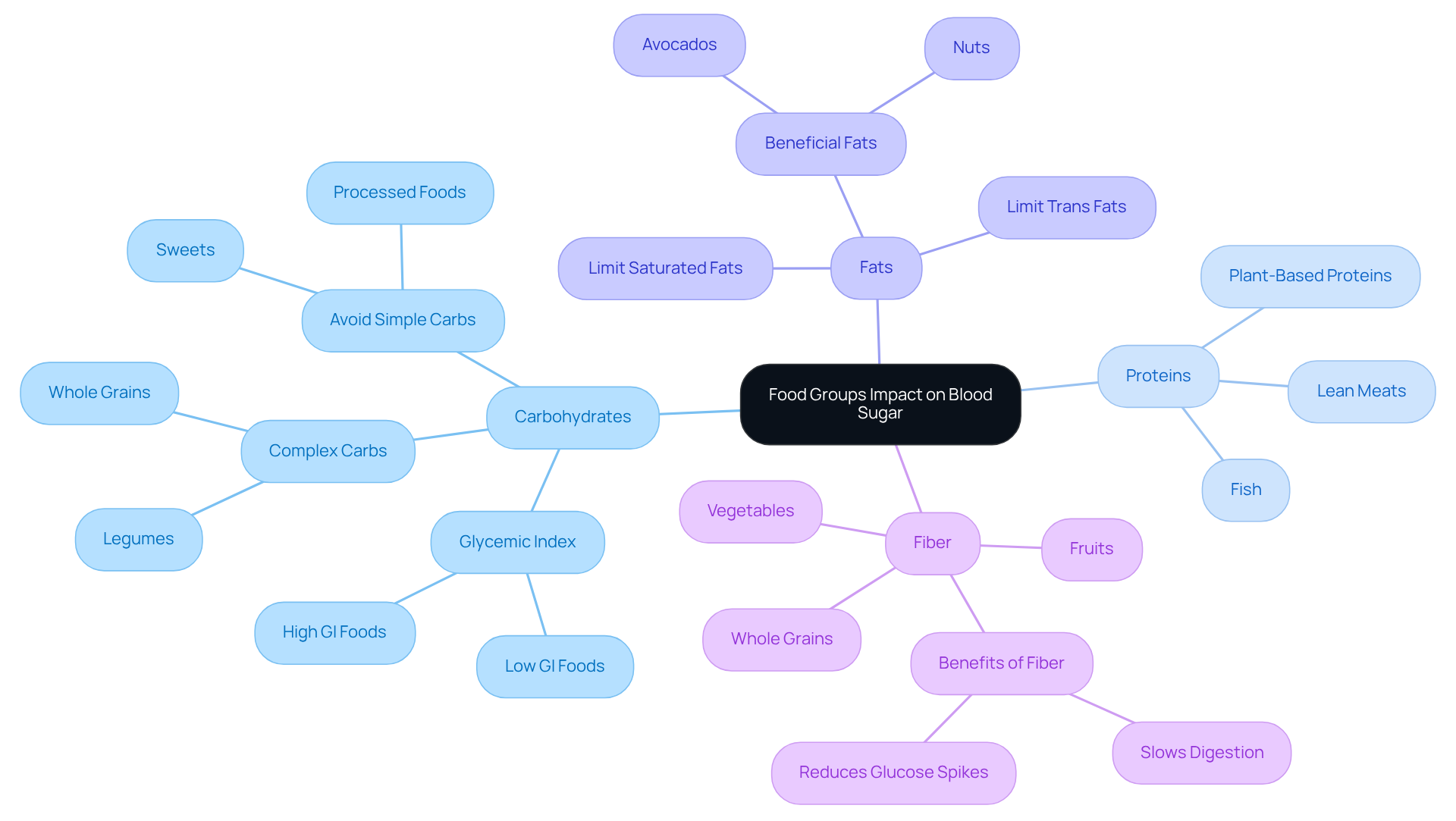Overview
Managing Type 2 Diabetes can feel overwhelming, but making informed dietary choices can truly make a difference. Focusing on whole foods, low glycemic index carbohydrates, and balanced macronutrients is essential for effectively regulating glucose levels.
Incorporating fiber-rich foods, healthy fats, and lean proteins not only helps stabilize blood sugar but also enhances your overall health. It's understandable to feel uncertain about what to eat, but remember that these choices are critical in your diabetes management journey.
You're not alone in this journey. Many have found that their dietary decisions play a significant role in their well-being. We are here to support you every step of the way, encouraging you to explore resources and seek guidance as you navigate your path to better health.
Introduction
Understanding the dietary needs of individuals with Type 2 Diabetes is essential for effectively managing this chronic condition. It’s completely normal to feel overwhelmed by the many dietary options available. With the right nutritional choices, you can significantly stabilize your glucose levels and enhance your overall health.
But what truly constitutes a diabetes-friendly diet? This article explores key dietary choices and strategies that empower you to take control of your health. We will shed light on the foods that not only support glucose regulation but also promote a balanced lifestyle, ensuring you feel supported every step of the way.
Understanding Type 2 Diabetes and Its Dietary Needs
Type 2 Diabetes is a long-lasting condition that affects your body's ability to process glucose. This happens mainly due to insulin resistance or inadequate insulin production. When this dysfunction occurs, glucose concentrations can rise, leading to serious health issues if not managed properly. It's important to know what to eat for diabetes type 2, as nutritional choices play a vital role in regulating glucose levels and preventing complications. A well-organized diet not only helps with weight control and enhances insulin sensitivity but also provides guidance on what to eat for diabetes type 2, supporting your overall health.
At T2DSolutions, we truly understand the importance of personalized dietary approaches for those living with Type 2 Diabetes. Recent research highlights what to eat for diabetes type 2, showing that dietary interventions focusing on:
- Whole foods
- Low glycemic index carbohydrates
- Balanced macronutrients
can greatly improve glycemic control. Nutritionists emphasize that understanding what to eat for diabetes type 2, including:
- Fiber-rich foods
- Healthy fats
- Lean proteins
can help stabilize glucose levels and promote metabolic health.
Moreover, successful dietary interventions have shown promising results in managing Type 2 Diabetes. For instance, individuals who follow structured meal plans can better understand what to eat for diabetes type 2, which often leads to improved glucose control and weight loss. This underscores the importance of recognizing what to eat for diabetes type 2, as it is crucial for effective management and enhancing quality of life. By making informed dietary choices regarding what to eat for diabetes type 2, you can take proactive steps toward better health outcomes.
You're not alone in this journey. We invite you to explore the resources and support available at T2DSolutions to assist you in managing Type 2 Diabetes. Together, we can work towards a healthier future.

Key Dietary Choices for Managing Type 2 Diabetes
Managing Type 2 Diabetes effectively can feel overwhelming, but understanding what to eat for diabetes type 2 can empower you on this journey. Emphasizing whole, nutrient-dense foods is a great place to start. Here are some key dietary choices that can support your health:
- Non-Starchy Vegetables: Think of filling your plate with vibrant non-starchy vegetables like leafy greens, broccoli, and bell peppers. These choices are low in calories and carbohydrates, making them wonderful allies for glucose control.
- Whole Grains: Incorporating whole grains such as brown rice, quinoa, and whole wheat bread is essential. These foods are rich in fiber, which plays a crucial role in managing glucose levels and enhancing digestive wellness.
- Lean Proteins: Including lean protein sources like chicken, turkey, fish, and legumes can help maintain your muscle mass and keep you feeling full, which can prevent overeating.
- Healthy Fats: Foods rich in nutritious fats, such as avocados, nuts, and olive oil, not only promote heart health but also aid in stabilizing glucose levels.
- Fruits: While fruits are naturally sweet, choosing whole fruits over juices and prioritizing lower glycemic index options like berries can provide vital nutrients without causing significant spikes in glucose levels.
These dietary selections not only help regulate glucose concentrations but also inform you about what to eat for diabetes type 2, enhancing your overall health and wellness. You're not alone in this journey; many individuals with Type 2 Diabetes are embracing whole foods as part of their lifestyle. Remember, this guidance includes information on what to eat for diabetes type 2 based on established dietary guidelines, and we are here to support you every step of the way.

The Role of Meal Timing and Composition in Diabetes Management
The Role of Meal Timing and Composition in Diabetes Management
Meal timing and composition play a crucial role in effectively managing Type 2 Diabetes. It's understandable to feel overwhelmed by the information, but research shows that maintaining consistent meal intervals can greatly stabilize glucose levels. Here are some essential considerations to guide you on this journey:
-
Regular Meal Times: Consistent meal timing is vital for regulating blood sugar and insulin responses. Studies indicate that adults who enjoy their first meal before 8:30 a.m. tend to exhibit lower insulin resistance compared to those who eat later. Moreover, late eaters may face a 20% greater glucose peak than those who consume their meals earlier. Remember, setting a regular schedule can make a significant difference.
-
Balanced Meals: Each meal should ideally combine carbohydrates, proteins, and healthy fats, especially when determining what to eat for diabetes type 2. This balance helps reduce glucose uptake into the bloodstream, preventing spikes in glucose levels. Experts recommend that breakfast, often referred to as 'breaking the fast,' should include at least two food groups to provide essential morning fuel, particularly when thinking about what to eat for diabetes type 2. Kendra Grinde-Busalacchi emphasizes that breakfast is important to give the body and brain the initial fuel to start the day. You're not alone in seeking the right balance; many share this journey.
-
Portion Control: Monitoring portion sizes is essential for effective management. The 'Diabetes Plate Method' is a practical tool for understanding what to eat for diabetes type 2: half your plate should consist of non-starchy vegetables, a quarter should be lean protein, and the remaining quarter should include whole grains or starchy vegetables. This visual guide helps you maintain appropriate portion sizes, making it easier to manage your meals.
-
Snacking Wisely: It's important to know what to eat for diabetes type 2, as nutritious snacks can help maintain energy and prevent glucose drops. Consider choices like nuts, yogurt, or raw vegetables, which can assist in keeping your glucose levels stable throughout the day. It's okay to indulge in snacks, just make sure they support your health goals.
-
Utilizing Technology: Continuous glucose monitors (CGMs) can be incredibly helpful in tracking your glucose levels effectively. They provide real-time data that can inform your meal timing and composition decisions, empowering you to make informed choices.
By prioritizing meal timing and composition, and consulting with your diabetes care team about what to eat for diabetes type 2 before making adjustments, you can enhance your glucose control and overall wellness. Remember, T2DSolutions is here to support you in your diabetes journey by offering educational materials and community support. You're not alone in this; together, we can ensure you have the resources needed for effective management.

Food Groups and Their Impact on Blood Sugar Levels
Understanding what to eat for diabetes type 2 and the impact of various food groups on blood sugar levels is crucial for effective diabetes management. You're not alone in this journey, and knowing how to navigate your diet can make a significant difference.
-
Carbohydrates: Carbohydrates exert the most significant influence on blood sugar levels. Choosing complex carbohydrates, like whole grains and legumes, is essential, as they are broken down more gradually compared to the simple carbohydrates in sweets and processed foods. It's understandable to feel overwhelmed, but studies indicate that high consumption of rapidly digestible carbohydrates is linked to poor glycemic control. That's why opting for lower glycemic index options is vital for your health.
-
Proteins: While proteins have a minimal direct impact on glucose, they play a supportive role in stabilizing glucose levels when eaten with carbohydrates. Lean meats, fish, and plant-based proteins are excellent choices. For instance, including protein-rich foods in your meals can help reduce glucose spikes, encouraging improved overall management of diabetes.
-
Fats: Beneficial fats, like those found in avocados and nuts, can slow the uptake of carbohydrates, resulting in more consistent glucose concentrations. However, it's important to limit saturated and trans fats, which can negatively affect heart health and insulin sensitivity. Remember, every small change counts.
-
Fiber: Foods rich in fiber, such as fruits, vegetables, and whole grains, are advantageous for regulating glucose levels. Fiber slows digestion and absorption, helping to prevent rapid spikes in glucose levels. Increasing your dietary fiber intake is associated with a lower risk of developing Type 2 Diabetes, highlighting its importance in a diabetes-friendly diet.
By understanding how these food groups interact with blood sugar, you can identify what to eat for diabetes type 2 and create balanced meals that align with your diabetes management goals. We are here to support you every step of the way, ultimately leading to improved health outcomes.

Conclusion
Understanding the dietary needs of individuals with Type 2 Diabetes is crucial for effective management and improved health outcomes. It's important to recognize that making informed choices about what to eat can significantly influence blood sugar levels, insulin sensitivity, and overall well-being. By focusing on whole foods, balanced macronutrients, and appropriate meal timing, you can take proactive steps toward managing your condition.
Key dietary choices, such as incorporating non-starchy vegetables, whole grains, lean proteins, and healthy fats, are essential components of a diabetes-friendly diet. Additionally, maintaining regular meal times and being mindful of portion sizes can further enhance glucose control. The role of carbohydrates, proteins, and fats in blood sugar regulation underscores the importance of a well-structured meal plan tailored to your individual needs.
Ultimately, understanding what to eat for Type 2 Diabetes is not just about dietary restrictions; it’s about empowering you to make choices that foster a healthier lifestyle. With the right support and resources, managing diabetes can become a more manageable and fulfilling journey. Embracing these dietary strategies can lead to improved health and a better quality of life. Remember, you are not alone in this journey—encouraging everyone to take charge of their health today is what this is all about.
Frequently Asked Questions
What is Type 2 Diabetes?
Type 2 Diabetes is a long-lasting condition that affects the body's ability to process glucose, primarily due to insulin resistance or inadequate insulin production.
Why is diet important for managing Type 2 Diabetes?
Nutritional choices play a vital role in regulating glucose levels and preventing complications, aiding in weight control, enhancing insulin sensitivity, and supporting overall health.
What dietary approaches are recommended for Type 2 Diabetes?
Recommended dietary approaches include focusing on whole foods, low glycemic index carbohydrates, and balanced macronutrients to improve glycemic control.
What types of foods should be included in a diet for Type 2 Diabetes?
A diet for Type 2 Diabetes should include fiber-rich foods, healthy fats, and lean proteins to help stabilize glucose levels and promote metabolic health.
How can structured meal plans benefit individuals with Type 2 Diabetes?
Structured meal plans can help individuals better understand what to eat for diabetes type 2, often leading to improved glucose control and weight loss.
What resources are available for managing Type 2 Diabetes?
T2DSolutions offers resources and support to assist individuals in managing Type 2 Diabetes, promoting a healthier future through informed dietary choices.



